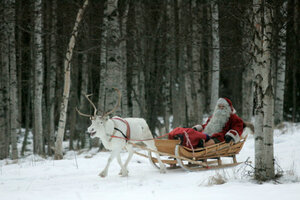Why Arctic reindeer are shrinking
Warmer Arctic winters have prevented reindeer grazing and stunted the growth of calves, a new study shows.

A man dressed as Santa Claus is pulled by a reindeer in Rovaniemi, Finland, 2007.
Kacper Pempel/Reuters/File
Climate change has helped breed a large population of weak reindeer, a new study suggests.
As a result of rising temperatures, many parts of the Arctic tundra are blanketed in winter ice, rather than snow. On the Arctic island chain of Svalbard, this has restricted the primary diet of local reindeer, which consists mainly of hardy evergreens and mosses that normally lie just beneath the snow.
In an expansion of an earlier study in the journal Global Change Biology, researchers found that the average weight of Arctic reindeer has dropped considerably in the past two decades. Toastier summers, however, have strengthened these stunted ungulates, leading to a higher rate of reproduction in the fall – a veritable boom of bantam reindeer.
“Warmer summers are great for reindeer but winters are getting increasingly tough,” lead author Steve Albon, an ecologist at the James Hutton Institute in Scotland, told Reuters. “So far we have more but smaller reindeer.”
As a whole, the decade has not been kind to reindeer populations. In 2006 and 2013, more than 80,000 Arctic reindeer perished from starvation. Those die offs were the result of warmer Arctic winters, as The Christian Science Monitor’s Zhai Yun Tan reported:
Over the past decade, warmer Arctic winters have caused more intense and frequent rainfall in the Barents and Kara seas near the Yamal peninsula, especially during fall and winter as the rapid melting of sea ice increased humidity in the atmosphere. More “rain-on-snow” events occurred as the rain hardened into an icy layer when the temperature fell in colder seasons.
Reindeer typically dig through layers of soft snow to eat lichen and vegetation. Adult males can even use their hooves to crack through ice, but “rain-on-snow” events have produced ice layers tens of centimeters thick, rendering some food sources all but unreachable. Calves that survive have tended to experience stunted growth.
Arctic summers are a different story. As seasonal temperatures reach higher peaks, plant life flourishes in the thaw. With an abundance of food, these smaller reindeer are healthy enough to conceive in autumn.
Researchers noted that the wild herd in Svalbard had grown to 1,400 individuals from just 800 in the past two decades. The average weight of adult reindeer, however, has fallen nearly 20 pounds in that time.
In Europe, too, warming climates have reduced reindeer grazing areas. The Sámi people of Scandinavia, who have traditionally relied on seasonal reindeer herding, have seen this change firsthand.
Emma Shorr, an agricultural blogger, reported for Food Tank:
Reindeer herding today looks much different than it once did in the region. Herders no longer walk or ski for hundreds of miles to find the best grazing grounds. Instead, they use mechanization and technology to make their livelihood feasible… [But] the modernized lifestyle still depends on traditional knowledge, especially when there are changing climate conditions.
The Sevettijarvi Declaration, written by indigenous representatives of the Indigenous Peoples' Biocultural Climate Change Assessment (IPBCCA), states, “On Skolt Sámi lands, waters don’t freeze in the same way anymore; and the in the autumn, instead of proper snow cover, ice rain falls on the ground, impacting reindeer food cycles.”
This report contains material from Reuters.

